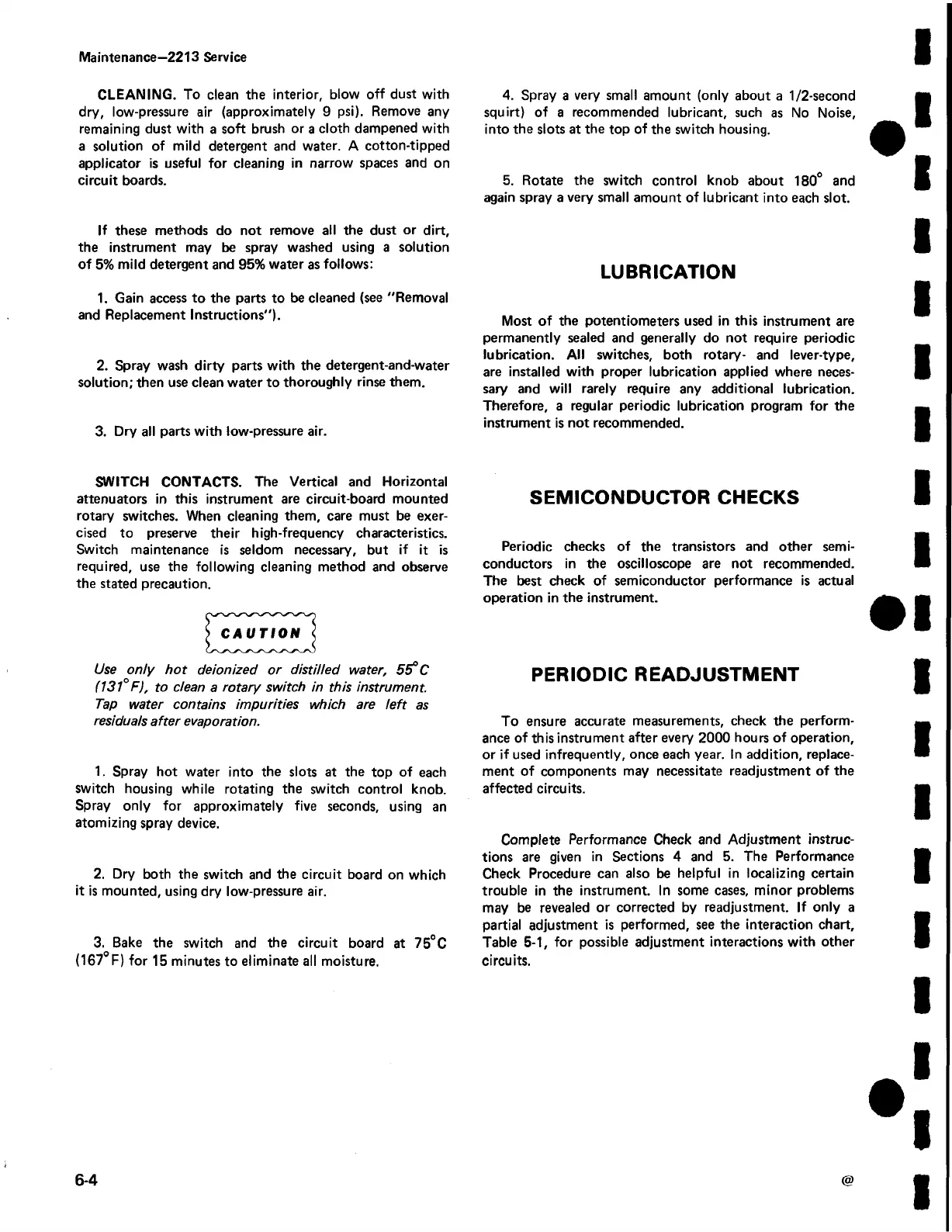Maintenance-2213 Service
CLEANING. To clean the interior, blow off dust with
dry, low-pressure air (approximately 9 psi). Remove any
remaining dust with a soft brush or a cloth dampened with
a solution of mild detergent and water. A cotton-tipped
applicator is useful for cleaning in narrow spaces and on
circuit boards.
If these methods do not remove all the dust or dirt,
the instrument may be spray washed using a solution
of 5% mild detergent and 95% water as follows:
1. Gain access to the parts to be cleaned (see "Removal
and Replacement Instructions").
2. Spray wash dirty parts with the detergent-and-water
solution; then use clean water to thoroughly rinse them.
3. Dry all parts with low-pressure air.
SWITCH CONTACTS. The Vertical and Horizontal
attenuators in this instrument are circuit-board mounted
rotary switches. When cleaning them, care must be exer
cised to preserve their high-frequency characteristics.
Switch maintenance is seldom necessary, but if it is
required, use the following cleaning method and observe
the stated precaution.
Use only hot deionized or distilled water, 55°C
(131° F), to dean a rotary switch in this instrument.
Tap water contains impurities which are left as
residuals after evaporation.
1. Spray hot water into the slots at the top of each
switch housing while rotating the switch control knob.
Spray only for approximately five seconds, using an
atomizing spray device.
2. Dry both the switch and the circuit board on which
it is mounted, using dry low-pressure air.
3. Bake the switch and the circuit board at 75°C
(167°F) for 15 minutes to eliminate all moisture.
4. Spray a very small amount (only about a 1/2-second
squirt) of a recommended lubricant, such as No Noise,
into the slots at the top of the switch housing.
5. Rotate the switch control knob about 180° and
again spray a very small amount of lubricant into each slot.
LUBRICATION
Most of the potentiometers used in this instrument are
permanently sealed and generally do not require periodic
lubrication. All switches, both rotary- and lever-type,
are installed with proper lubrication applied where neces
sary and will rarely require any additional lubrication.
Therefore, a regular periodic lubrication program for the
instrument is not recommended.
SEMICONDUCTOR CHECKS
Periodic checks of the transistors and other semi
conductors in the oscilloscope are not recommended.
The best check of semiconductor performance is actual
operation in the instrument.
PERIODIC READJUSTMENT
To ensure accurate measurements, check the perform
ance of this instrument after every 2000 hours of operation,
or if used infrequently, once each year. In addition, replace
ment of components may necessitate readjustment of the
affected circuits.
Complete Performance Check and Adjustment instruc
tions are given in Sections 4 and 5. The Performance
Check Procedure can also be helpful in localizing certain
trouble in the instrument. In some cases, minor problems
may be revealed or corrected by readjustment. If only a
partial adjustment is performed, see the interaction chart.
Table 5-1, for possible adjustment interactions with other
circuits.

